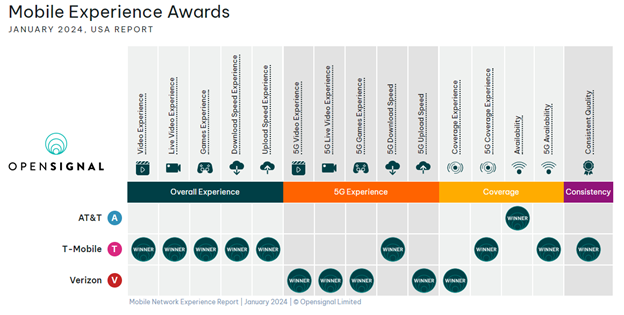Verizon’s nationwide coverage is clearly the best, but T-Mobile’s 5G network speeds are unbeatable
Best Cell Phone Coverage
*All data speed and coverage data taken from Opensignal’s January 2024 Mobile Network Experience Report1
There are three major cell phone networks in the United States: AT&T, T-Mobile, and Verizon.
Of the three, Verizon has the best nationwide coverage. But that doesn’t mean it’s the best everywhere, it just means that it has better coverage in more areas on average. This makes it ideal for folks who live in rural areas or travel often.
Meanwhile, T-Mobile has the largest 5G network, which means fast download speeds and performance overall. AT&T isn’t the best at anything nationwide, but it does come out on top in specific geographic areas.
We’ll go into all the details here, including in-depth coverage maps, interviews with customers, and performance data. By the end, you should have a very good idea of which company has the best cell phone coverage for you.
Guide to Best Cell Phone Coverage:
Honest reviews written by real people
Why should you trust Reviews.org? Because we are real people writing these reviews, and we talk to real people in order to research them.
Our brand partners do not see or approve our articles before they are published, but we make a commission if you click an affiliate link. Learn more about Reviews.org on our About Us page.
Comparing plans for the best coverage
Before we dive into all of the details about coverage, we thought we’d show you a quick breakdown of some of the most affordable plans on each of the networks.
We included one plan from each of the big three carriers, as well as one plan from a cheaper, MVNO carrier that uses each network (Mint Mobile uses T-Mobile, Visible uses Verizon, and Consumer Cellular uses AT&T).
Defining good coverage
There was a time when coverage was all about a single metric: where each cell phone carrier allowed you to make a call. But with data being such an important component of cell phone coverage now, it’s about more than just dead zones. It’s also about what kind of coverage you get in different areas.
There are currently three different network technologies operating in the U.S.: 4G, LTE, and 5G. All three of these kinds of networks let you make calls, send texts, and use mobile data. However, 4G is the slowest and 5G is the fastest. LTE is somewhere in the middle.
When we discuss each carrier’s coverage, we’ll talk about these different kinds of networks. We’ll also talk about what Opensignal—a third-party cellular coverage data collector—calls “coverage experience.”
Opensignal defines coverage experience as a metric that “represents the experience users receive as they travel around areas where they would reasonably expect to find coverage.” In other words, it’s not just about where coverage exists, but about how much coverage there is in the places you expect to have coverage, like highways, homes, workplaces, and other venues.
Opensignal also provides a number of other categories for rating network coverage. We’ll discuss several of these throughout, but here is a snapshot of how each of the major three carriers did in Opensignal’s latest report.

Image source: screenshot from Opensignal
Regionally specific cell phone coverage
We’ll talk a lot about nationwide coverage in this article. But it’s important to note that no company has the best coverage everywhere. There are specific locations where each of the three major networks has clear dominance. As one person we spoke with for this piece, Liam, noted “Coverage is constantly changing. The best carrier for you depends heavily on your specific location and usage patterns.”
We’ll use information that we’ve gathered from real customers, as well as RootMetrics reports to analyze how good carrier coverage is in specific locations.
One very useful tool for understanding network coverage on the granular level is this awesome map from the FCC, which allows you to click on any location in the U.S. and see exactly what networks are available there.
That’s enough for the introductions. Let’s get into the nitty-gritty coverage details. We’ll start with the star of the show: Verizon.
Verizon Wireless: Best nationwide coverage
Taking a broad view, Verizon Wireless has the best coverage in the United States. It will give you more bars in the places you need them than any other carrier. This fact is verified by Opensignal’s latest report, which gives Verizon the gold medal for Coverage Experience. But it is also backed up by tons of anecdotal data from everyday users.
Before we talk more in-depth about Verizon’s network, here’s a look at an interactive map. You can zoom into any location in the United States to see the coverage of Verizon’s 4G and 5G networks in granular detail.
While T-Mobile has been catching up with its huge 5G network, and AT&T still has the best coverage in certain areas, Verizon’s network is better overall. That’s because it simply has more towers in more places where people expect to have good service.
When we interviewed Brianne Sandorf about her experience using Verizon in Utah and while traveling, she told us that “the coverage was really good. My husband has T-Mobile, and often when he didn't have coverage, I did.”
This is a common refrain from Verizon customers: They have coverage when their friends and family don’t. One Reddit user named SilverConfection has phones on all three networks, but uses Verizon as their “car phone” because it gets better coverage in rural areas. “Living in Tulsa and frequently driving to Dallas, the only dead spot I encounter with [Verizon] 4G availability is in the middle of the Creek Turnpike,” they write.
Of course, AT&T or T-Mobile happen to have better coverage in certain areas. As we noted at the top, coverage is very regionally specific. But if you travel frequently, move around a lot, or work in rural areas, then Verizon is most likely to keep you covered.
Verizon data speeds and 5G
In Opensignal’s latest report, Verizon wins in every single 5G category except for raw download speeds. Users report unparalleled satisfaction when it comes to streaming live video, playing games, and doing other common activities on Verizon 5G.
That’s probably because Verizon has invested significant resources into creating a type of 5G network called millimeter-wave or wide-band. This type of 5G network doesn’t have the same range as others, like those created by T-Mobile and AT&T, but it is significantly faster. It’s this powerful 5G network that also powers Verizon’s 5G Home Internet service.
Unfortunately, Verizon’s 5G cell phone coverage is not the best. It’s really centered in certain specific metropolitan areas, like Las Vegas, Miami, New York City, Salt Lake City, San Diego, and Philadelphia.
When it comes to 4G and LTE service, Verizon’s data performance is not as strong. According to numerous customer reports and third-party data, T-Mobile has the fastest 4G network, more than doubling the average speeds offered by AT&T and Varizon.
If you sign up for a qualifying unlimited data plan from Verizon, you can get some significant savings on Verizon’s high-speed fiber internet plans.
Our favorite Verizon plan
When we spoke with Brianne Sandorf about her time with Verizon, she said that she and her husband “really liked Verizon, but our plan with them costs twice as much. We were each paying $45 a month.” This is why they eventually switched to another provider.
It’s not an uncommon story. You have to pay a premium for the best cell phone coverage in the U.S. That said, there are some Verizon Wireless plans that we think are worth it, like the Verizon Unlimited Welcome plan.
With this plan you get unlimited talk, text, and data on Verizon’s 4G and 5G networks. Plus, you can add perks like 100GB Mobile Hotspot or International TravelPass Days for $10 a month.
Carriers that use Verizon’s network
If you want to get on Verizon’s network without paying such a high monthly cost, you can sign up for an MVNO plan that uses the same cell phone towers. There are many smaller, prepaid providers that use Verizon’s network, like CREDO Mobile, Visible, Red Pocket, and TracFone.
T-Mobile: Best 5G coverage
T-Mobile has been steadily gaining ground in the coverage wars ever since its merger with Sprint back in 2018. It’s been shrinking its big dead zones and expanding 5G faster than any other carrier.
When we asked T-Mobile customers about their experience with the carrier on Quora, we saw mixed feedback. Users were impressed with 5G coverage and download speeds, but they mentioned issues with coverage gaps.
One self-described technology enthusiast, Liam, wrote that “T-Mobile has been rapidly expanding but may still have gaps compared to Verizon in very remote locations.” That basically sums it up: T-Mobile is getting better fast, but in terms of overall coverage, it’s not quite as strong as Verizon.
You can take a look for yourself with this interactive T-Mobile coverage map.
T-Mobile data speeds and 5G
While T-Mobile doesn’t have the best 4G cell phone coverage, it does have the fastest download speeds by a good margin. This is clearly reflected in Opensignal’s data.

Image source: screenshot from Opensignal
This data from Opensignal is also backed up by RootMetrics, which stated in its latest report that “T-Mobile continued to deliver the fastest aggregate median download speed in our national testing at 250.0Mbps (up from 213.2Mbps last time), but perhaps even more impressive is that T-Mobile earned a share of the US Network Accessibility RootScore Award, which looks at how quickly users can connect to the network.”
T-Mobile’s median download speeds of 250Mbps make it faster than many home internet providers! This makes T-Mobile ideal for mobile gamers or folks who regularly use their phone to stream or Zoom into a work meeting.
Part of what makes T-Mobile’s data so fast is its gigantic 5G network. T-Mobile is the clear winner in Opensignal’s 5G Coverage Experience category.

Image source: screenshot from Opensignal
Unlike Verizon, which has focused on building wide-band and highly localized 5G networks, T-Mobile has gone for the more-is-better approach. Liam, who we spoke with through Quora, mentioned that T-Mobile’s “mid-band 5G offers a great balance of speed and coverage.”
This mix of speed and coverage is exactly what makes T-Mobile’s 5G home internet service so popular. It can reach places where many other internet providers simply can’t offer high-speed connections. For mobile customers, it just means crisper video streams, faster loading times, and cleaner online gameplay all across the U.S.
Our favorite T-Mobile plan
T-Mobile’s prices are the cheapest of the big three providers, but they are still higher than most MVNO plans. We think there are several plans worth considering from T-Mobile, but the mid-level Magenta plan is our favorite.
This plan gets you a full 100GB of premium, unthrottled data. It also gives you unlimited data and texting in 215+ countries and an automatic 5GB of mobile hotspot data. That’s quite a bit more than the similarly priced Verizon Unlimited Welcome plan offers.
Other ways to get on T-Mobile’s network
T-Mobile shares its network with several other, smaller MVNO carriers, like Altice, Boost Mobile, and Mint Mobile. If you want to get onto T-Mobile’s superfast 4G/5G networks without paying full-price, these carriers may be the way to go.
AT&T: Best in the Midwest and the South
AT&T has fewer claims to fame when it comes to coverage, but that doesn’t make it a bad choice for everyone. (Full disclosure: I’m on AT&T!) The company doesn’t boast the best nationwide coverage overall or the highest data performance. However, in certain areas and contexts, it’s definitely the right choice.
In RootMetrics latest report it states that “AT&T’s performance in state-level testing remained impressive, with the carrier’s 249 State RootScore Awards the highest of any carrier.” This state level testing rates carriers using several different metrics—like reliability, accessibility, speed, and text—in specific geographic regions.
This means that AT&T’s strong performance in specific states made up for its less impressive performance on the national level.
So, just where does AT&T offer the best cell phone coverage? Let’s start with this interactive map, which will show you where AT&T’s 4G and 5G networks are strong and where there are dead spots.
As you can see, much of the South, Midwest, and the two coasts are awash in AT&T network coverage. According to data from RootMetrics, AT&T is particularly strong in cities like Little Rock, Chicago, Raleigh-Durham, Richmond, Atlanta, Miami, and Austin.
Anecdotally speaking, as someone who has been on AT&T for over 10 years, it has some clear pros and cons. When I lived in Salt Lake City, I saw great coverage throughout the metro area. But I would often lose coverage in rural parts of the state while my friends on Verizon still had it.
Now, living in a small town in New England, I often have service when my friends on other carriers don’t. However, if we go to the nearest major city, I notice some dead zones.
AT&T data speeds and 5G
When you’re within AT&T’s 4G or 5G network range you should see reasonable download speeds. While, taken on average, AT&T’s speeds can’t match T-Mobile’s, they do actually outpace Verizon’s. Here’s the data from Opensignal.

Image source: screenshot from Opensignal
While 4G and LTE speeds are good, AT&T’s 5G network coverage definitely leaves something to be desired. It lags behind both Verizon and T-Mobile. In my own personal experience, I’ve never seen the 5G logo appear on my phone, even when passing through major cities.
AT&T is one of the biggest and best internet providers in much of the Midwest and South. AT&T customers who have certain unlimited data plans can get a discount when they sign up for internet as well.
Our favorite AT&T plan
AT&T’s plans are pricier than T-Mobile’s and around the same as Verizon’s. There are several postpaid unlimited data plans to choose from, but we think the Unlimited Extra plan is the way to go. If you opt for any of AT&T’s cheaper plans they come with the risk of data deprioritization.
With the Unlimited Extra plan, you’ll get 75GB of premium data, 30GB of Mobile Hotspot data, and other perks. Brianne Sandorf has been particularly impressed with AT&T’s international coverage since switching, telling Reviews.org that “I didn't get free coverage in Europe with Verizon, which I do with AT&T (as long as I sign up for the free plan and submit the dates beforehand).”
Other ways to get on AT&T’s network
Just like the other two major networks, AT&T leases out its network bandwidth to third-party MVNO carriers, like Cricket, Red Pocket, and Consumer Cellular. Here are some of our favorite plans from cheap carriers that use AT&T’s network.
Recap: Which carrier has the best coverage?
- Verizon: Verizon offers the best nationwide coverage overall, giving you more bars in more places. Its 5G network is limited, but it is very fast where it is available.
- T-Mobile: T-Mobile has some significant coverage gaps in certain areas of the West, but it does well in metropolitan areas. It makes up for its worse coverage with lightning fast data speeds and an ever-expanding 5G network.
- AT&T: AT&T’s coverage is decent throughout the United States, but it is especially good in parts of the Midwest and South. Its 5G network is the smallest of the three, but it still has some decent coverage in metro areas.
Methodology
This review of cell phone coverage began with an exhaustive research phase. We consulted dozens of different sources, including third-party analysts like Opensignal, online customer reviews, direct interviews with customers, our own proprietary data, and cell phone carriers’ claims. Ultimately, we ranked the providers based on a number of criteria, including:
- Overall nationwide coverage: Which carrier gives users the most bars in the most places?
- 5G network coverage: Which carrier has the biggest 5G network?
- Data performance: Which carrier has the best data speeds?
- Specific geographic network performance: Which carriers perform best in specific locations?
We tried to provide this information in an easily-readable and transparent way, so that our readers can pick the best carrier for them and their specific lifestyle. We hope that we’ve helped you find the perfect cell phone plan.
Related Articles




